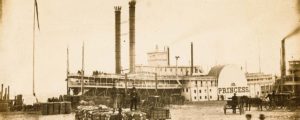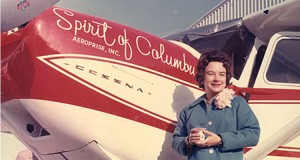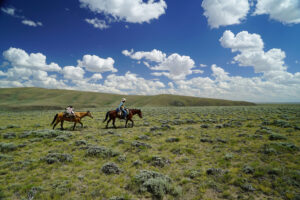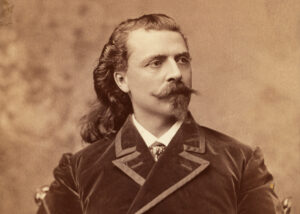Tybo sits on the eastern slope of the Hot Creek Range in Nye County, Nevada. Shoshone Indians alerted whites to canyon-side silver veins in 1866. In 1870 James W. Gally and M.V.B. Gillett claimed the main silver lode, which became the Two-G Mine. The boom began in 1874, officials platted a town and buildings sprang up.
The post office also arrived in 1874. By 1876 the young town boasted five stores, two blacksmith shops, numerous saloons and 1,000 inhabitants. At least 16 mule-drawn outfits moved freight from Eureka to Tybo and returned with lead and silver bullion. More than 250 tons of bullion left Tybo monthly in 1877, making it the nation’s top lead-producing district.
Tybo was divided geographically— Upper, Middle and Lower Tybo occupied different elevations astride the steep canyon—and ethnically, with strife between the Irish, Cornish, Central Europeans and Swiss-Italians. Still, all children attended the redbrick schoolhouse.
In 1877 the Eureka Daily Sentinel reported: “Among the mining properties gaining a prominent position in mining circles can be numbered that of the Tybo Consolidated Company….Two smelting furnaces have been erected, a refinery, where the bullion is separated, is also in successful operation, and within the past year a 20-stamp mill has been set up.”
Local kilns burned piñon pinewood to produce the charcoal that fueled the smelting furnaces (see related story, P. 26). The Daily Sentinel noted, “The company, owning large tracts of woodland in the vicinity of its mines and near Hot Creek, [has] started to do its own burning and making coal…by the use of brick kilns, built circular, 22 feet in width and 25 feet high.” Today more than a dozen charcoal kilns exist near Tybo.
Tybo was the site of Nevada’s 1876 “Chinese War,” when a labor shortage prompted the hiring of Chinese woodcutters at wages equal to those paid white workers. The Workingmen’s Protective Union, including some Swiss-Italian carbonari, fortified with liquor, stormed the Chinese camp at midnight and put the workers to flight. The labor contractor’s men prevailed in bringing them back, despite a roadside standoff with a dozen armed union men. The opponents exchanged ultimatums, and bloodshed seemed likely. The Chinese themselves ended the ugly incident, offering to leave in exchange for stage fare to Eureka, which the Anti-Asiatic League of Tybo provided.
The Belmont Courier recorded Tybo’s first murder in 1877: “A fatal shooting affray occurred in Tybo at about 5 o’clock last Tuesday evening in Events & Kinds Saloon. [It] commenced in a playful way between Stewart…Mart Tupper and some other parties, but it soon became personal in its nature and resulted in Stewart stabbing Tupper while he was sitting in a chair. Tupper immediately got up from the chair and started for the front door. Stewart followed him up; Tupper drew a pistol and fired three shots, the second and third taking effect and causing almost instant death. It is the general opinion that Tupper was justified in the shooting of Stewart.” Tupper died of his own wounds five days later.
Another 1877 Courier article told of “the discovery in our midst of a man possessed of a devil. An attempt would likely have been made to exorcise the evil spirit by subjecting the possessor to a coat of tar and feathers and possibly severer treatment had the latter not made a rapid and sudden exit from the town on foot. This human fiend, G. Roycroft…was apprehended in making suggestions and proposals to the schoolgirls of Tybo by means of a letter [of] so foul and obscene a nature that the severest penalties of the law would be mild punishment.”
In 1879 the company closed the smelters, putting 400 men out of work, and adopted the new process of crushing and roasting the ore. Tybo became less profitable as silver-rich surface ore at the Two-G yielded to greater proportions of zinc and lead. The Treadwell-Yukon Company revived operations in 1929, but the post office closed for good in October 1937. Few buildings but plenty of foundations survive, and Tybo still claims a few residents.
The dirt road to Tybo off U.S. 6 bisects Basecamp Airfield, a U.S. Air Force strip that UFO enthusiasts believe is a backup runway for Area 51. The base was built to support the Project Faultless underground nuclear test in 1968.
Robert H. Wynn operates the Web site Ghost Town Seekers [www.robertwynn.com]. Thomas J. Straka is a forestry and natural resources professor at Clemson University.
Originally published in the June 2010 issue of Wild West. To subscribe, click here.




